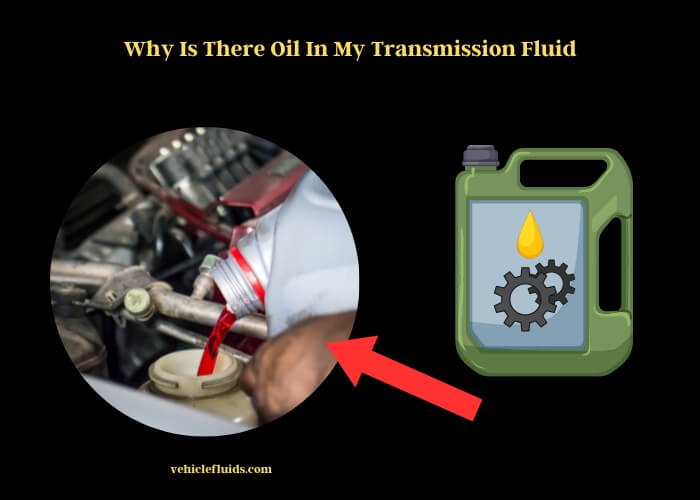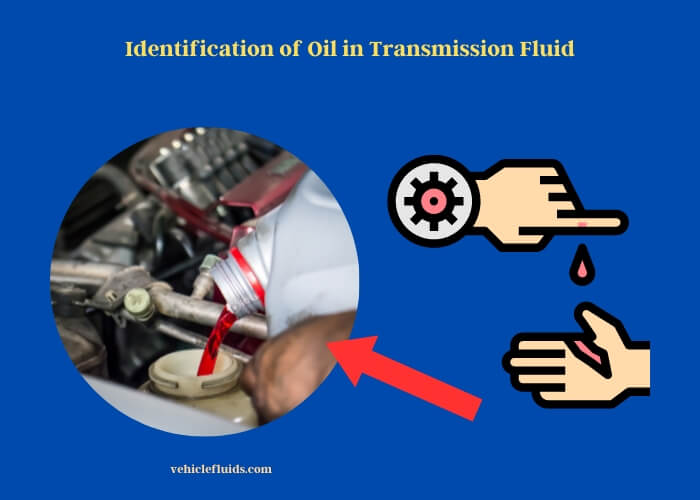Oil in your transmission fluid can indicate various issues, from leakage to seal failure. These problems can have serious consequences if left unattended, potentially leading to more significant damage to your vehicle’s transmission system.
Leakage could be a sign of weak or damaged seals in the transmission system. The seals are designed to keep oil and transmission fluid separate, and any failure may allow them to mix. Incorrect servicing can also lead to oil contamination. This can happen if the transmission fluid is not changed properly or if the wrong tools are used, causing cross-contamination.
A malfunctioning radiator can be another culprit. The radiator cools both engine oil and transmission fluid, but if it malfunctions, these two may mix, leading to oil in your transmission fluid. Gasket deterioration is a similar issue, where the gasket that separates the oil and transmission fluid wears out, leading to mixture of the two fluids.

Transmission cooler failure and problems with the oil cooler lines can also result in oil mixing with your transmission fluid. These components are responsible for maintaining the temperature of the fluids. If they fail, they can cause mixing. Overfilling the transmission fluid or engine oil can also result in cross-contamination. It can cause the pressure within the systems to rise, leading to leaks and mixing.
Lastly, using the wrong type of fluid can result in oil in your transmission fluid. Different vehicles require specific types of fluids, and using the incorrect one can lead to issues like cross-contamination. To avoid these problems, always ensure you use the correct type of fluid and perform regular checks and maintenance on your vehicle.
Composition and Functionality of Transmission Fluid
Basic Ingredients in Transmission Fluid
Transmission fluid is more than just oil. It’s a complex mix of base oil and additives designed to meet the specific demands of your vehicle’s transmission. These additives can include detergents to keep the transmission clean, anti-wear agents to protect moving parts, and viscosity modifiers to ensure the fluid performs optimally across a range of temperatures.
Operational Role of Transmission Fluid
Transmission fluid’s primary role is lubricating the transmission’s moving parts. This lubrication reduces friction, minimizing wear and tear while ensuring smooth operation. It also serves as a coolant to help manage the heat generated within the transmission. Furthermore, in automatic transmissions, the fluid helps transfer power from the engine to the drivetrain.
Characteristics and Functions of Key Ingredients in Transmission Fluid
| Ingredient | Characteristic | Function |
| Base Oil | High thermal stability | Provides lubrication |
| Detergents | Contain dispersants | Keep transmission clean |
| Anti-wear agents | Chemically reactive | Protect moving parts |
| Viscosity Modifiers | Sensitive to temperature | Ensure optimal performance at various temperatures |
The Role and Properties of Motor Oil
Components and Types of Motor Oil
Motor oil, like transmission fluid, is a blend of base oil and additives. The base oil makes up most of the volume and provides the fundamental lubricating properties. The additives, on the other hand, provide specific enhancements like reducing engine wear, preventing corrosion, and improving fuel economy.
Main Tasks of Motor Oil
The motor oil lubricates the engine’s moving parts, reducing friction, and thereby preventing excessive wear. It also draws heat away from the combustion cycle and inhibits the build-up of varnish and carbon deposits. More than just a lubricant, motor oil contributes to engine cleanliness and enhances overall engine performance.
Comparison of Key Properties and Functions of Transmission Fluid and Motor Oil
| Properties | Transmission Fluid | Motor Oil |
| Lubrication | High | High |
| Cooling | Moderate | High |
| Cleaning | High | Moderate |
| Power Transfer | High (in automatic transmissions) | N/A |
| Prevention of Corrosion | Low | High |
| Fuel Economy | N/A | Depends on the oil grade |
Design of Separate Fluid Systems
Distinct Needs of Engines and Transmissions
Engines and transmissions have different requirements, warranting separate fluid systems. The engine needs motor oil with high heat tolerance to handle the combustion heat, while the transmission requires a fluid that can handle power transfer, particularly in automatic transmissions.
The Rationale Behind Isolated Fluid Systems
Separate fluid systems ensure that the distinct needs of both engines and transmissions are met without compromise. It also prevents cross-contamination, which can lead to decreased performance or even damage. This design consideration contributes to the longevity and reliability of the vehicle as a whole.
Circumstances that Cause Oil Contamination in Transmission Fluid
Defective Seals
Seals that have become worn or damaged over time can allow engine oil to leak into the transmission. It’s also possible for an incorrectly installed seal to cause this issue. This is why regular vehicle inspection is crucial to identify and replace defective seals promptly.
Neglected Vehicle Maintenance
Failure to adhere to recommended maintenance schedules can lead to various issues, including oil contamination in the transmission fluid. Over time, parts wear out, seals degrade, and without timely intervention, these can lead to cross-contamination of fluids.
Malfunctioning Transmission Coolers
Transmission coolers are a part of the system that cools the transmission fluid. If a cooler leaks, it may allow engine coolant to mix with the transmission fluid. While not engine oil per se, the effect can be similarly harmful.
Errors during Fluid Replacement
Mistakes during fluid changes, like filling transmission fluid into the engine oil intake or vice versa, can lead to contamination. It underscores the need for careful handling of vehicle fluids, especially during maintenance tasks.
Identification of Oil in Transmission Fluid

Warning Signs and Symptoms
There are several indicators that might suggest the presence of oil in your transmission fluid. Changes in the color of the fluid, from its normal red to a brown or black, can be a clear sign. The vehicle might also show performance issues such as slipping gears, overheating, or unusual noises from the transmission.
Techniques for Checking Your Transmission Fluid
One of the easiest ways to check for oil in your transmission fluid is through a dipstick examination. The fluid should be red, clear, and free of any particles. If the fluid is dark, has a burnt smell, or contains particles, it might be contaminated with oil or other substances.
Ramifications of Oil Contamination in Transmission Fluid
Potential Harm to the Transmission System
The presence of oil in the transmission fluid can cause significant harm to the transmission system. It can alter the fluid’s viscosity, causing it to become less effective at lubricating and cooling the transmission. Over time, this can lead to overheating, increased wear and tear, and potentially, complete transmission failure.
Effect on Vehicle Operation
Oil contamination in the transmission fluid can negatively impact vehicle operation. It can lead to erratic shifting in automatic transmissions, reduced fuel efficiency, and in severe cases, complete loss of the ability to shift gears.
Preventative Measures Against Oil Contamination in Transmission Fluid
Regular Vehicle Servicing
Regular vehicle servicing is the first line of defense against oil contamination in transmission fluid. Regular checks and prompt replacement of worn-out seals, gaskets, and other parts can help prevent the issue.
Quality Seals and Coolers
Investing in quality seals and coolers can also help prevent oil contamination. These parts should be able to withstand high temperatures and pressures without failing, reducing the risk of leaks that can lead to contamination.
Proper Techniques for Handling Fluids
Using the right techniques and procedures when handling vehicle fluids can also help prevent contamination. This includes correctly identifying fluid intake points and using clean, dedicated funnels and containers for each fluid type.
Preventative Measures and Their Impact on Reducing Oil Contamination
| Preventative Measure | Impact |
| Regular Vehicle Servicing | Significant |
| Investing in Quality Seals and Coolers | Moderate to High |
| Proper Handling of Vehicle Fluids | Significant |
Disputing Misconceptions About Transmission Fluid Contamination
Common Misbeliefs and Their Corrections
There are several misconceptions about transmission fluid contamination. For instance, some believe that a small amount of oil won’t hurt the transmission, but even a little can cause significant damage over time. Others think that it’s an issue that only occurs in older vehicles, but even new cars can experience it if their maintenance has been neglected or if parts are defective.
Value of Reliable Information
Getting reliable information is crucial in ensuring the health of your vehicle. Misinformation can lead to costly repairs and potentially dangerous situations on the road. It’s always best to consult with professional mechanics or trusted automotive resources for accurate information.
Frequently Asked Questions
Can Engine Oil Get into Automatic Transmission?
Yes, engine oil can potentially find its way into the automatic transmission, typically due to a faulty seal. Seals can wear out or get damaged over time, allowing oil to leak into the transmission.
Can I Put Motor Oil in My Transmission?
No, you should not put motor oil in your transmission. Both motor oil and transmission fluid are specifically formulated for their respective systems, and using the wrong fluid can lead to damage and potential failure of the system.
What Happens If I Put Transmission Fluid in My Oil?
Introducing transmission fluid into your engine can be harmful. The engine’s oil has specific properties to handle high temperatures, and transmission fluid lacks these characteristics. Over time, this can cause damage to your engine, leading to reduced performance and potentially serious damage.
What Happens If You Put Motor Oil in Automatic Transmission?
If you put motor oil in your automatic transmission, it can cause significant damage. Motor oil has different properties and is not designed to handle the unique demands of a transmission system, like power transfer in automatic transmissions.
What Happens If You Put Oil in the Transmission?
Using oil instead of transmission fluid in your transmission can lead to serious issues. These include erratic shifting in automatic transmissions, reduced fuel efficiency, and, in severe cases, the inability to shift gears.
What Happens If You Put Transmission Fluid in the Oil?
Adding transmission fluid to your oil can lead to detrimental effects. Transmission fluid lacks the properties needed to properly lubricate the engine and handle the heat from the combustion process. This can result in poor engine performance or even engine failure.
What Are the Effects of a Small Amount of Motor Oil in Transmission?
Even a small amount of motor oil in the transmission fluid can cause damage over time. The oil can alter the fluid’s viscosity, making it less effective at lubricating and cooling the transmission, potentially leading to overheating and increased wear and tear.
Read more:
